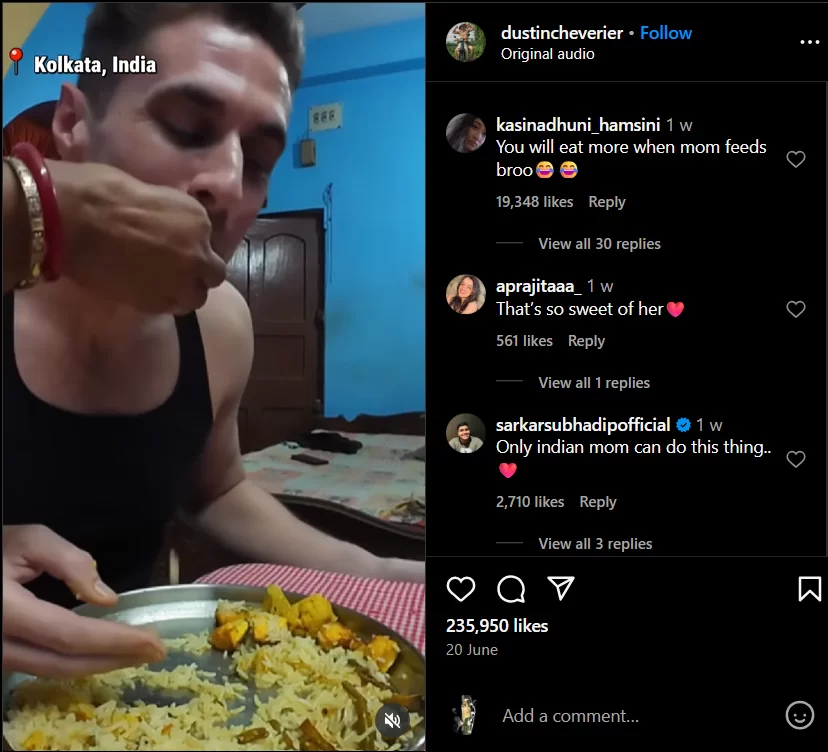- Monday, June 30, 2025
Using hands to feed or eat is not just practical but symbolic—hands are considered extensions of the heart, conveying warmth and affection. This tactile interaction strengthens the bond between mother and child, making mealtime a nurturing experience rather than just a routine.

By: Vibhuti Pathak
While this phenomenon is very common in Indian households, it is very rare and unique for Americans to watch or witness this. A touching video of US vlogger Dustin Cheverier being fed lovingly by an Indian mother has gone viral, resonating deeply with viewers worldwide.
The clip, shared on Instagram during Dustin’s visit to India, shows him sitting with a woman—presumed to be a friend’s mother—who gently mixes dal and rice with her hands and feeds him bite by bite. This simple act of care and affection is a cherished part of Indian maternal tradition and left Dustin visibly emotional.
In the video, Dustin smiles warmly as he says, “Mum is mixing my food for me, just to make sure I eat it right.” The caption, “Indian Mom Feeds Me Like A Baby,” perfectly captures the tenderness and cultural significance of the moment.
View this post on Instagram
Emotional Responses Flood Social Media
The video struck a chord with social media users, many of whom shared their own memories of similar experiences. Comments poured in recalling childhood moments when friends’ mothers fed them lovingly, describing the gesture as “pure love” and a uniquely Indian expression of hospitality.
One viewer wrote, “Only in India will you be treated like family, even if you’re a guest.” Others highlighted the emotional and healing power of such acts, with one person saying, “My mom used to do this when I was stressed. It’s not just food; it’s healing.” For some, the video brought tears, like a commenter who shared, “I lost my mum recently, and this video brought tears to my eyes. It’s such a small act, but filled with so much love.”
Many appreciated the cultural practice of hand-mixing and feeding, emphasizing that it symbolizes care and connection. “This is why I always tell my kids — never forget the hands that fed you,” one user reflected.
Why Do Indian Mothers Feed Kids by Hand? Cultural, Scientific Reasons
Feeding children by hand is a longstanding tradition in India, rooted in deep cultural values of love, care, and connection. Using hands to feed or eat is not just practical but symbolic—hands are considered extensions of the heart, conveying warmth and affection. This tactile interaction strengthens the bond between mother and child, making mealtime a nurturing experience rather than just a routine.
Scientifically, eating with hands can enhance the sensory experience of food. The touch of food stimulates nerve endings on the fingertips, which can increase appetite and enjoyment. The warmth of the hands can also enhance the aroma and texture perception, making the meal more satisfying. Additionally, the practice encourages mindfulness, helping individuals connect more deeply with their food and eating habits.
In Indian culture, eating with hands is also linked to Ayurveda, the ancient system of medicine, which teaches that the five fingers correspond to the five elements—earth, water, fire, air, and ether. Using hands to eat is believed to balance these elements within the body, promoting health and digestion.
A Celebration of Indian Hospitality and Tradition
The viral video is a beautiful reminder of the warmth and soul of Indian hospitality. It showcases how simple, loving gestures—like a mother feeding her child by hand—carry profound meaning. This tradition reflects the importance of family, care, and connection in Indian culture, values that transcend borders and touch hearts everywhere.
Dustin Cheverier’s heartfelt experience highlights how cultural exchanges can foster appreciation and emotional bonds, reminding us all of the universal language of love expressed through food and care.